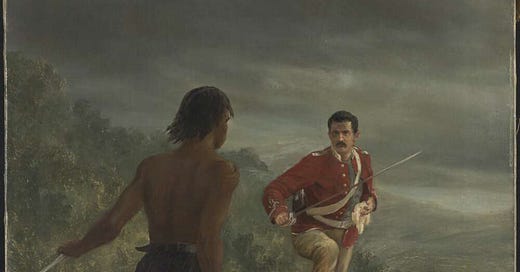The Weeping Woman: the Hauhau religion and Historical Background
This was originally posted as a thread on our Twitter
Nestled in a small garden park in the NZ town of Wanganui, a statue of a weeping woman resides. But many have forgotten who she weeps for, and what weeping Wanganui would have done if those whom she weeps did not perish in their fight against the fanaticism and barbarism of the dreaded 'Hauhau'.
In 1864, the major Taranaki settlement of Wanganui was at risk of being raided and sacked by a large band of fanatical Maori following a syncretic religion known as 'Pai Mārire' or simply Hauhauism.
Founded by Te Ua Haumēne, the Hauhau faith was a mix of Christianity and pagan Maori religion. In an apparent vision to Te Ua by the Archangel Gabriel in 1862, Gabriel told Te Ua that the end days of the Bible were at hand, that God had chosen him to be the Prophet that would expel the Europeans and restore Israel (the Maori) to the land of Canaan (New Zealand). Essentially, the Maori were the 'second chosen people' according to Te Ua.
The Anglican Bishop of Waiapu thought that he was insane. Historian Walter Gudgeon called him a "harmless lunatic" and that "his tribe looked on him as of weak intellect, but yet of peaceful disposition."
While never explicitly advocating for violence between Maori and Europeans, Te Ua's followers (often led by his chosen disciples) quickly became notorious for their barbarism against settlers and soldiers alike. Similarly, their relationship with other Maori tribes deteriorated, as conflict between them and the new religion arose.
Some of the more gruesome aspects of the religion reflected the cannibalism of pre-colonial Maori. After attacking a group of armed settlers, 'Archangel Gabriel' allegedly appeared before them - proclaiming that the severed heads of those they had killed should be exhumed and used in certain Hauahu rites, with the skull being used as a medium to speak to God.
John E. Moultray: 'A Trooper of the Wanganui Cavalry attacked by the Hau-hau' (1892).
In May of 1864, a band of 300 Hauhau warriors made their way downstream towards Wanganui - led by one of Te Ua's 'disciples' - seeking to raze the settlement and possibly slaughter its inhabitants, adults and children alike.
However, on their way there they were blocked by the island of Moutoa in the middle of the Wanganui River. The two Kūpapa chiefs (chiefs loyal to the British) Hōri Kīngi Te Ānaua and Hoani Wiremu Hīpango refused their Hauhau cousins passage towards the town and fighting ensued - causing the deaths of 50 Hauhau, 14 Kūpapa and one European (a Catholic lay brother who was shot whilst observing the fight).
Wanganui was saved and shortly after news of the fight spread throughout the colony, the province of Wellington (which contained Wanganui at the time) voted in council to construct a memorial for those who had fought and died to save the settlement.
The statue of the Weeping Woman then appeared in the Moutoa Gardens, symbolising the perceived loyalty of "those brave men who fell at Moutoa 14 May 1864 in defence of law and order against fanaticism and barbarism." It became New Zealand's first war memorial.
Isaac Featherston, the superintendent of Wellington province at the time, said that the statue will "act on the natives as the Victoria Cross on the British Troops, will, in fact, be to them a Victoria Cross. It will, I am convinced, stimulate the natives who are about to accompany the gallant forces, Imperial and Colonial, under General Chute, on an expedition against the treacherous, plundering, murdering tribes on the [west] coast, to still greater deeds of valor".
Now, the descendants of those upriver Maori see the statue as 'offensive' and as such all the typical faces show up to advocate for its removal. As a consequence of the weak-willed Whanganui District Council, they have decided to prepare for its imminent removal without public consultation.
Consequently, the Zealandia Heritage Foundation has partnered with Stop Co-Governance to promote protest action against the removal of our oldest war memorial, and historic piece of New Zealand's heritage in the face of Maori tribal elites who are clearly ashamed but unwilling to admit their own past errors in bastardising the Christian faith.
WE WEEP TOO.





